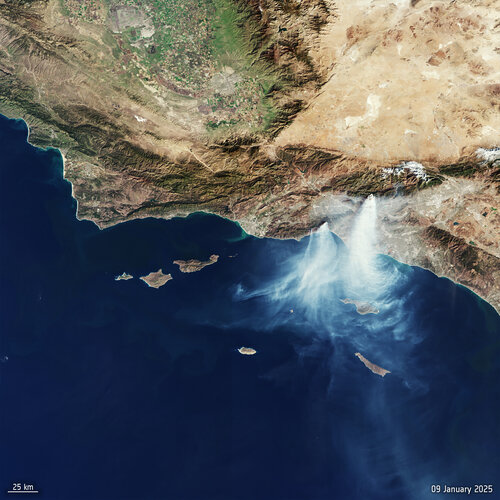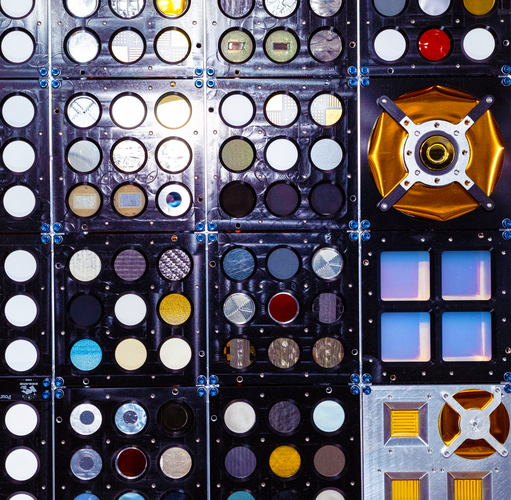
Copernical Team
Friday, 10 January 2025 12:26
Blue Origin pushes 1st New Glenn rocket launch attempt to early Sunday
This request seems a bit unusual, so we need to confirm that you're human. Please press and hold the button until it turns completely green. Thank you for your cooperation!
Press and hold the button
If you believe this is an error, please contact our support team.
185.132.36.159 : 2a928b6e-827d-45ad-9761-372d36ef
Published in
News
Tagged under
Friday, 10 January 2025 15:11
NASA instrument on Firefly's Blue Ghost Lander to study lunar interior
This request seems a bit unusual, so we need to confirm that you're human. Please press and hold the button until it turns completely green. Thank you for your cooperation!
Press and hold the button
If you believe this is an error, please contact our support team.
185.132.36.159 : d793f3d8-ff74-4da8-be59-6721f2f0
Published in
News
Tagged under
Friday, 10 January 2025 13:40
Los Angeles struggles to contain wildfires
 Image:
Five wildfires are still currently burning (as of 10 January) in areas of north Los Angeles. This image, captured by the Copernicus Sentinel-3 mission on 9 January 2025, shows the Palisades and the Eaton fires, with smoke seen reaching Catalina Island and the Santa Barbara reserve.
Image:
Five wildfires are still currently burning (as of 10 January) in areas of north Los Angeles. This image, captured by the Copernicus Sentinel-3 mission on 9 January 2025, shows the Palisades and the Eaton fires, with smoke seen reaching Catalina Island and the Santa Barbara reserve.
Published in
News
Tagged under
Friday, 10 January 2025 17:43
Week in images: 06-10 January 2025

Week in images: 06-10 January 2025
Discover our week through the lens
Published in
News
Tagged under
Friday, 10 January 2025 09:15
In a materials world
 Image:
In a materials world
Image:
In a materials world
Published in
News
Tagged under
Friday, 10 January 2025 06:17
SIIS Signs MOU with Pixxel to Expand Hyperspectral Data Solutions in Korea
Sydney, Australia (SPX) Jan 10, 2025
 SIIS Co., Ltd. (CEO Kim Moon-Gyu) has formalized a memorandum of understanding (MOU) with Pixxel, a US-India-based space technology enterprise known for its hyperspectral satellite constellation. The agreement, signed on November 19th during the Satellite Utilization Conference, paves the way for introducing hyperspectral satellite data to Korean institutions and businesses.
Pixxel's advan
SIIS Co., Ltd. (CEO Kim Moon-Gyu) has formalized a memorandum of understanding (MOU) with Pixxel, a US-India-based space technology enterprise known for its hyperspectral satellite constellation. The agreement, signed on November 19th during the Satellite Utilization Conference, paves the way for introducing hyperspectral satellite data to Korean institutions and businesses.
Pixxel's advan
 SIIS Co., Ltd. (CEO Kim Moon-Gyu) has formalized a memorandum of understanding (MOU) with Pixxel, a US-India-based space technology enterprise known for its hyperspectral satellite constellation. The agreement, signed on November 19th during the Satellite Utilization Conference, paves the way for introducing hyperspectral satellite data to Korean institutions and businesses.
Pixxel's advan
SIIS Co., Ltd. (CEO Kim Moon-Gyu) has formalized a memorandum of understanding (MOU) with Pixxel, a US-India-based space technology enterprise known for its hyperspectral satellite constellation. The agreement, signed on November 19th during the Satellite Utilization Conference, paves the way for introducing hyperspectral satellite data to Korean institutions and businesses.
Pixxel's advan
Published in
News
Tagged under
Friday, 10 January 2025 06:17
Rocket Lab to Provide Hypersonic Test Launches for Department of Defense
Los Angeles CA (SPX) Jan 10, 2025
 Rocket Lab USA, Inc. (Nasdaq: RKLB) ("Rocket Lab" or "the Company"), a global leader in space systems and launch services, has been selected as part of a team led by Kratos Defense and Security Solutions, Inc. (Nasdaq: KTOS) ("Kratos") for a major Department of Defense (DoD) contract. The five-year Other Transaction Agreement (OTA) for the Multi-Service Advanced Capability Hypersonic Test Bed (M
Rocket Lab USA, Inc. (Nasdaq: RKLB) ("Rocket Lab" or "the Company"), a global leader in space systems and launch services, has been selected as part of a team led by Kratos Defense and Security Solutions, Inc. (Nasdaq: KTOS) ("Kratos") for a major Department of Defense (DoD) contract. The five-year Other Transaction Agreement (OTA) for the Multi-Service Advanced Capability Hypersonic Test Bed (M
 Rocket Lab USA, Inc. (Nasdaq: RKLB) ("Rocket Lab" or "the Company"), a global leader in space systems and launch services, has been selected as part of a team led by Kratos Defense and Security Solutions, Inc. (Nasdaq: KTOS) ("Kratos") for a major Department of Defense (DoD) contract. The five-year Other Transaction Agreement (OTA) for the Multi-Service Advanced Capability Hypersonic Test Bed (M
Rocket Lab USA, Inc. (Nasdaq: RKLB) ("Rocket Lab" or "the Company"), a global leader in space systems and launch services, has been selected as part of a team led by Kratos Defense and Security Solutions, Inc. (Nasdaq: KTOS) ("Kratos") for a major Department of Defense (DoD) contract. The five-year Other Transaction Agreement (OTA) for the Multi-Service Advanced Capability Hypersonic Test Bed (M
Published in
News
Tagged under
Friday, 10 January 2025 06:17
ReOrbit and Ananth Technologies Collaborate on GEO Satellite Development
Berlin, Germany (SPX) Jan 10, 2025
 ReOrbit, a prominent provider of software-driven satellites for secure communications, has formalized a Memorandum of Understanding (MoU) with Ananth Technologies, a leading Indian aerospace and defense manufacturer. This strategic agreement aims to explore joint initiatives in the design and development of geostationary orbit (GEO) communications satellites.
The partnership, outlined in t
ReOrbit, a prominent provider of software-driven satellites for secure communications, has formalized a Memorandum of Understanding (MoU) with Ananth Technologies, a leading Indian aerospace and defense manufacturer. This strategic agreement aims to explore joint initiatives in the design and development of geostationary orbit (GEO) communications satellites.
The partnership, outlined in t
 ReOrbit, a prominent provider of software-driven satellites for secure communications, has formalized a Memorandum of Understanding (MoU) with Ananth Technologies, a leading Indian aerospace and defense manufacturer. This strategic agreement aims to explore joint initiatives in the design and development of geostationary orbit (GEO) communications satellites.
The partnership, outlined in t
ReOrbit, a prominent provider of software-driven satellites for secure communications, has formalized a Memorandum of Understanding (MoU) with Ananth Technologies, a leading Indian aerospace and defense manufacturer. This strategic agreement aims to explore joint initiatives in the design and development of geostationary orbit (GEO) communications satellites.
The partnership, outlined in t
Published in
News
Tagged under
Friday, 10 January 2025 01:49
NASA Lander Will Demonstrate Vacuum-Based Lunar Sample Collection
Los Angeles CA (SPX) Jan 10, 2025
 NASA is preparing to showcase a cutting-edge sample collection method on the Moon as part of its ongoing efforts to revolutionize planetary exploration. The Lunar PlanetVac (LPV), a key technology demonstration payload, will be carried to the lunar surface aboard Firefly Aerospace's Blue Ghost 1 lander. This mission falls under the agency's Commercial Lunar Payload Services (CLPS) initiative, ai
NASA is preparing to showcase a cutting-edge sample collection method on the Moon as part of its ongoing efforts to revolutionize planetary exploration. The Lunar PlanetVac (LPV), a key technology demonstration payload, will be carried to the lunar surface aboard Firefly Aerospace's Blue Ghost 1 lander. This mission falls under the agency's Commercial Lunar Payload Services (CLPS) initiative, ai
 NASA is preparing to showcase a cutting-edge sample collection method on the Moon as part of its ongoing efforts to revolutionize planetary exploration. The Lunar PlanetVac (LPV), a key technology demonstration payload, will be carried to the lunar surface aboard Firefly Aerospace's Blue Ghost 1 lander. This mission falls under the agency's Commercial Lunar Payload Services (CLPS) initiative, ai
NASA is preparing to showcase a cutting-edge sample collection method on the Moon as part of its ongoing efforts to revolutionize planetary exploration. The Lunar PlanetVac (LPV), a key technology demonstration payload, will be carried to the lunar surface aboard Firefly Aerospace's Blue Ghost 1 lander. This mission falls under the agency's Commercial Lunar Payload Services (CLPS) initiative, ai
Published in
News
Tagged under
Friday, 10 January 2025 01:49
Artemis I Orion Spacecraft Back in Florida
Los Angeles CA (SPX) Jan 10, 2025
 The Orion crew module, designated as the Orion Environmental Test Article (ETA), has returned to NASA's Kennedy Space Center in Florida after an extensive 11-month test campaign at the Neil Armstrong Test Facility in Sandusky, Ohio. The spacecraft's arrival on December 21, 2024, marks another step in preparing for future Artemis missions.
This is a return visit to Kennedy for the ETA. Afte
The Orion crew module, designated as the Orion Environmental Test Article (ETA), has returned to NASA's Kennedy Space Center in Florida after an extensive 11-month test campaign at the Neil Armstrong Test Facility in Sandusky, Ohio. The spacecraft's arrival on December 21, 2024, marks another step in preparing for future Artemis missions.
This is a return visit to Kennedy for the ETA. Afte
 The Orion crew module, designated as the Orion Environmental Test Article (ETA), has returned to NASA's Kennedy Space Center in Florida after an extensive 11-month test campaign at the Neil Armstrong Test Facility in Sandusky, Ohio. The spacecraft's arrival on December 21, 2024, marks another step in preparing for future Artemis missions.
This is a return visit to Kennedy for the ETA. Afte
The Orion crew module, designated as the Orion Environmental Test Article (ETA), has returned to NASA's Kennedy Space Center in Florida after an extensive 11-month test campaign at the Neil Armstrong Test Facility in Sandusky, Ohio. The spacecraft's arrival on December 21, 2024, marks another step in preparing for future Artemis missions.
This is a return visit to Kennedy for the ETA. Afte
Published in
News
Tagged under

